预约演示
更新于:2025-07-19
177Lu-Pentixather
更新于:2025-07-19
概要
基本信息
非在研机构- |
权益机构- |
最高研发阶段临床1/2期 |
首次获批日期- |
最高研发阶段(中国)- |
特殊审评- |
登录后查看时间轴
关联
2
项与 177Lu-Pentixather 相关的临床试验NCT06356922
Phase I/II Study Assessing Radioligand Therapy (RLT) Using [177Lu]Lu-PentixaTher for Relapsed/Refractory CXCR4+ Acute Leukemia.
CXCR4 inhibition may represent a new therapeutic strategy in acute leukemia (AL) patients, not only by increasing chemosensitivity but also by preventing relapse of the disease by disruption of the interaction of residual leukemic cells with the bone marrow niche. Radiolabeled CXCR4 ligands have been developed for PET imaging (68Ga-PentixaFor; INN: Gallium (68Ga) boclatixafortide) and radioligand therapy (RLT) ([177Lu]Lu-PentixaTher/[90Y]Y-PentixaTher). [177Lu]Lu and [90Y]Y-PentixaTher have been tested in three multiple myeloma patients in named-patient use with a remarkable efficacy in 2 patients (Herrmann, 2016). Moreover, feasibility of CXCR4 PET imaging in AML was reported, providing a framework for future theranostic approaches targeting the CXCR4/CXCL12-defined leukemia-initiating cell niche (Herhaus, 2016).
Here a Phase I/II study to determine maximal tolerated dose (MTD) of a RLT using [177Lu]Lu-PentixaTher in relapsed/refractory AL was designed. This will be a standard phase I/II 3+3 dose escalation study. Five dose levels will be tested, so 6 to 21 patients have to be included in the study.
Here a Phase I/II study to determine maximal tolerated dose (MTD) of a RLT using [177Lu]Lu-PentixaTher in relapsed/refractory AL was designed. This will be a standard phase I/II 3+3 dose escalation study. Five dose levels will be tested, so 6 to 21 patients have to be included in the study.
开始日期2024-10-22 |
申办/合作机构 |
CTIS2022-501019-15-00
- RC20_0123
开始日期- |
申办/合作机构- |
100 项与 177Lu-Pentixather 相关的临床结果
登录后查看更多信息
100 项与 177Lu-Pentixather 相关的转化医学
登录后查看更多信息
100 项与 177Lu-Pentixather 相关的专利(医药)
登录后查看更多信息
9
项与 177Lu-Pentixather 相关的文献(医药)2025-01-01·Theranostics
CXCR4-directed endoradiotherapy with [177Lu]Pentixather added to total body irradiation for myeloablative conditioning in patients with relapsed/refractory acute myeloid leukemia
Article
作者: D'Alessandria, Calogero ; Götze, Katharina S ; Rudelius, Martina ; Lorenzini, Theo ; Braitsch, Krischan ; Hefter, Maike ; Eiber, Matthias ; Peeken, Jan C ; Nickel, Katharina ; Bassermann, Florian ; Koch, Katrin ; Verbeek, Mareike ; Allmann, Anne ; Brosch-Lenz, Julia ; Herhaus, Peter ; Weber, Wolfgang
Rationale: Despite recent advances in the targeted therapy of AML, the disease continues to have a poor prognosis. Allogeneic hematopoietic stem cell transplantation (alloSCT) remains to be the curative therapy option for fit patients with high-risk disease. Especially patients with relapsed or refractory (r/r) AML continue to have poor outcomes. Myeloablative total body irradiation (TBI) based conditioning can be used in AML patients refractory to multiple lines of standard therapy, but the optimal conditioning regimen remains unclear for patients considered to be chemotherapy- refractory. Feasibility of C-X-C-motif chemokine receptor 4 (CXCR4)-directed endoradiotherapy (ERT) has previously been demonstrated in AML patients with CXCR4 expression on leukemic blasts. Methods: Here, we report on a small cohort of seven AML patients refractory to multiple lines (range 3-7) of therapy, who received CXCR4-directed ERT with [177Lu]Pentixather in combination with TBI and chemotherapy prior to alloSCT. We report outcomes with a focus on toxicity, engraftment, the impact on the bone marrow (BM) niche and efficacy. Results: In this intensively pre-treated group of patients, promising response (6 out of 7 patients) and engraftment (6 out of 7 patients) rates were observed. Histopathological analysis showed that niche compartments are spared and allow for engraftment to occur despite the combined ERT and TBI conditioning. Conclusion: To the best of our knowledge, we report on the first seven patients who received CXCR4-directed ERT in sequential combination with TBI and chemotherapy, providing an effective, individualized conditioning regimen for intensively pre-treated r/r AML patients.
2023-11-21·RADIATION RESEARCH
Chemokine Receptor CXCR4 Radioligand Targeted Therapy Using 177Lutetium-pentixather for Pulmonary Neuroendocrine Cancers
Article
作者: Ewald, Jordan T. ; Graves, Stephen A. ; O'Dorisio, Thomas M. ; Fath, Melissa A. ; Bellizzi, Andrew M. ; Menda, Yusuf ; Robles-Planells, Claudia ; Howe, James R. ; Rastogi, Prerna ; Liu, Dijie ; Tomanek-Chalkley, Ann M. ; Spitz, Douglas R. ; O'Dorisio, M Sue
Intermediate to high-grade lung neuroendocrine tumors (NETs; i.e., atypical carcinoid tumors) and neuroendocrine carcinomas (NECs) are currently difficult to cure. These tumors were found to express the CXCR4 G-protein coupled receptor that can be targeted with radioligands. PCR and flow cytometric analysis of lung NET and NEC cell lines using an anti-CXCR4 antibody demonstrated that all cell lines tested expressed CXCR4. PET/CT imaging with 68Galium-pentixafor in mouse xenografts of NETs and NECs verified tumor targeting that was blocked by a CXCR4 agonist. Clonogenic survival analysis demonstrated a more than additive enhancement of killing when 1 μM auranofin (a thioredoxin reductase inhibitor) was used as a radiosensitizer in combination with 177Lu-pentixather (10 μCi). DMS273 small cell lung cancer xenografts in female nude mice treated with 25 μCi/g 177Lu-pentixather induced inhibition of tumor growth and resulted in an increase in overall survival without causing unacceptable normal tissue toxicities. Immunohistochemical staining of 95 retrospective human samples (containing 90 small cell lung carcinomas) demonstrated 84% CXCR4 positivity. In a multivariable analysis of this cohort that included age, gender, stage, primary site, SSTR2 status, and CXCR4 status, Cox regression models determined that only distant metastasis at presentation (P < 0.01) and a CXCR4 H-score >30 (P = 0.04) were significantly associated with reduced survival. Prospective clinical testing of patient tumors identified CXCR4-positivity in 76% of 21 NECs, 67% of 15 lung NETs (including 8 of 10 atypical carcinoids), and 0% of 25 non-lung NETs (including 5 NETS G3s). These data support the hypothesis that CXCR4-targeted theranostics can be utilized effectively for select NETs and NECs.
2023-04-01·Mini reviews in medicinal chemistry
Nuclear Medicine Application of Pentixafor/Pentixather Targeting CXCR4
for Imaging and Therapy in Related Disease
Review
作者: Chen, Zhenying ; Yao, Shaobo ; Xue, Qianqian
::
68Ga-Pentixafor, as a radiolabeled tracer, shows high specificity and affinity for CXCR4 in tumors.
Thus, CXCR4-directed imaging with 68Ga-Pentixafor has been investigated to evaluate CXCR4 expression
in patients non-invasively. In recent years, many small cohorts, including those of individuals
with hematologic malignancies, solid tumors, and cardiovascular and infectious diseases, have been
reported. So far, 68Ga-Pentixafor has been used successfully in individuals with hematologic malignancies.
In addition, Lutetium-177 (177Lu) or Yttrium-90 (90Y)-labeled Pentixather (an analog of
Pentixafor) suggested high potential applicability in tumor endoradiotherapy (ERT) with CXCR4
overexpression. Patients with advanced-stage multiple myeloma, refractory acute leukemia, and diffuse
large B-cell lymphoma received a certain amount of 177Lu-Pentixather or 90Y-Pentixather. This
review aimed to overview the current CXCR4-directed positron emission computed tomography
(PET) molecular imaging based on Pentixafor in several diseases and ERT.
1
项与 177Lu-Pentixather 相关的新闻(医药)2025-05-06
·创药网
近年来,核药领域迎来爆发式增长。在精准医疗与诊疗一体化理念驱动下,核药创新技术加速升级,呈现出"核素迭代、靶标拓展、平台创新"等创新趋势。新型α核素药物、新功能靶向分子、智能开发平台等技术突破正重塑核药研发范式。本文概述了传统靶标优化及新兴靶标拓展、创新型放射性标记核药平台,供研发人员参考。近年来,核药领域迎来爆发式增长。据统计,2024年核药市场规模达175亿美元,复合增长率13.48%,全球临床阶段核药管线超600项。在精准医疗与诊疗一体化理念驱动下,核药创新技术加速升级,呈现出"核素迭代、靶标拓展、平台创新"等创新趋势。新型α核素药物、新功能靶向分子、智能开发平台等技术突破正重塑核药研发范式。随着诺华Pluvicto在转移性去势抵抗性前列腺癌治疗中的成功,核药产业竞争焦点已从同位素选择转向系统性技术革新。三、传统靶标优化及新兴靶标拓展一直以来,靶向生长抑素受体(SSTR)和PSMA的药物一直是放射治疗诊断学领域的“明星产品”。目前在研药物的热门靶标还包括:CXC族趋化因子受4(CXCR4)、成纤维母细胞活化蛋白(FAP)、人类表皮受体生长因子2(HER2)和神经降压素受体(NTR)等。其中,PSMA是当前核药研发的最热门靶标,涉及项目数量最多,覆盖前列腺癌、乳腺癌及2024年新进入临床阶段的项目。紧随其后的胃泌素释放肽受体(GRPR)、神经营养因子受体酪氨酸激酶(NTRK)靶标也展现出较高的研发活跃度,主要聚焦于肺癌、胃癌和神经内分泌瘤等适应症。111In-ProstaScint是FDA最早批准上市(1996年获批)的靶向PSMA的前列腺癌放射性诊断药物。环五肽68Ga-Pentixafor是目前研究最深入的靶向CXCR4的分子探针,应对治疗所用的化合物为Pentixather。FAP是肿瘤精准诊疗颇具潜力的理想靶标,目前一些靶向FAP放射性药物被广泛研究。传统靶标如诺华靶向PSMA的Pluvicto已获批用于转移性去势抵抗性前列腺癌(mCRPC),现已拓展至早期激素敏感性前列腺癌(mHSPC);另有研究使用Pluvicto联合PARP抑制剂奥拉帕利治疗BRCA突变患者;最重要的是随着α核素升级,治疗效果有所提升。针对SSTR2的优化也包括适应症的扩展,如诺华的Lutathera以及远大医药的¹⁷⁷Lu-DOTA-TATE已在脑膜瘤、小细胞肺癌及胶质瘤领域开始开展临床试验。值得关注的是,随着研究的不断深入,越来越多的新靶标逐渐进入科研人员的视野,核药的靶标选择正从传统的PSMA、SSTR向更具潜力的新兴靶标拓展(图2)。包括FAP在泛癌种中的治疗潜力。数据显示,68Ga-FAPI PET显像在肝癌中的灵敏度超90%;诺华的177Lu-FAP-2286的作用机制为依靠177Lu靶向FAP阳性肿瘤细胞以及周围的FAP阴性肿瘤细胞,从而导致DNA损伤和细胞死亡,目前,该药正在进行I期临床试验,用于广谱肿瘤治疗。当前核药管线中FAP-α临床前项目有42项,显示出较高的热度。国内北京大学团队也提出了靶向共价放射性药物(CTR)的理念,开发共价FAP探针(CTR-FAPI),在早期研究中,放药68Ga-CTR-FAPI PET-CT,显著提高了对甲状腺髓样癌病灶的灵敏度;治疗功能方面,国内蓝纳成生物启动了1项FAP靶标诊疗一体化临床试验(CTR20240127),评价177Lu-LNC1004注射液在FAP阳性的晚期恶性实体瘤患者中的安全性和耐受性。其它靶标方面,针对CXCR4的研究主要在血液系统肿瘤(如淋巴瘤)和神经内分泌肿瘤的显像。68Ga-pentixafor针对多种疾病包括边缘区淋巴瘤等多种肿瘤显像已进入Ⅲ期临床试验。90Y-pentixather和177Lu-pentixather主要用于治疗多发性骨髓瘤、T细胞淋巴瘤、惰性非霍奇金淋巴瘤等处于I/Ⅱ期临床阶段。此外,203Pb-pentixather和212Pb-pentixather等药物处于I期临床试验。针对PD-L1(程序性死亡配体1)的研究,主要表现在免疫治疗协同的潜力明显,有研究开发的全D型多肽核药[⁶⁴Cu/⁶⁸Ga]DPA,实时监测PD-L1表达,可指导免疫治疗患者分层。另有临床研究显示放射性核素标记PD-L1抗体(如¹⁷⁷Lu-atezolizumab)联合PD-1抑制剂,黑色素瘤ORR提升至65%。当前,PD-L1在临床前及I期临床占比高,显示出较强的潜力。另有一些低活跃度靶标的研发如CA9(碳酸酐酶IX)主要针对肾细胞癌和低氧相关肿瘤。远大医药的TLX250-CDx(靶向CA9)海外Ⅲ期临床呈现积极数据,已在国内开始I期临床试验首例入组;故可开发CA9特异性放射性治疗药物,用于低氧耐药性肿瘤的精准治疗。核药在靶标选择上,肿瘤的表面受体蛋白仍然是最受到关注的靶标类型。随着对肿瘤生物学和疾病机制的深入研究,越来越多的潜在靶标被发现,如一些与肿瘤微环境、免疫调节相关的靶标逐渐受到关注,有望为核药研发提供更多的方向和机会。AB图2:2024年活跃的核药项目Top20靶标(A按总数排序;B按已公布研究阶段分布)四、创新型放射性标记核药平台1. 高效放射性标记平台技术Radiopharm Theranostics是一家专注于放射性药物开发的临床阶段生物技术公司,核心策略是通过靶向放射性核素治疗(TRT)与诊疗一体化技术,解决实体瘤治疗中的靶向性、疗效与安全性难题。其核心技术包括高亲和力放射性螯合剂(High-Affinity Radiometal Chelators)与靶向纳米粒子传输(Targeted Nanoparticle Delivery),可实现更稳定的放射性核素偶联,并减少体内非特异性分布,形成差异化竞争优势,在诊疗一体化与泛癌种适应症拓展上展现出显著优势。2. AI+精准放射性药物平台配体的结构设计和修饰是解决放射性药物缺乏问题的关键要素。人工智能(AI)在预测生物分子的三维结构、指导新型放射性药物的合成方面不断取得突破(图3)。放射性配体治疗研究存在结合亲和力不足、靶标筛选和分子优化难度大等局限,AI可以准确预测所设计蛋白质的结构,在此基础上,根据结合位点氨基酸侧链的取向,设计出可以准确结合的蛋白质,实现更好的结合亲合力,将配体、螯合剂、放射性核素整体作AI设计,得到结构稳定性的全新结构。AI技术通过数据整合能力(跨模态数据关联)、计算模拟效率(减少实验试错)、动态优化能力(实时调整研发路径),能够缩短放射性药物研发周期,同时提高成功率并降低成本,推动诊疗一体化发展。图3:AI赋能核药开发概念图3. 预靶向技术预靶向(pre-targeting)技术是指先注射特异性抗体,使其在肿瘤部位积累,再注射小分子放射性配体,使其与已积累的抗体发生自连接,从而实现疾病显像和治疗。与传统核药相比,预靶向药物兼具抗体靶向肿瘤的特异性和放射性标记小分子的药代动力学特征,有效减少了放射性核素的体内循环时间,降低了体内的总辐射吸收剂量,堪称基于抗体的传统放射免疫疗法的升级替代版。在该系统中,首先给药的是带有标签的非放射性标记抗体。抗体在足够的时间从血液中消除后,使用可与标签结合的放射性标记的二次剂,通常采用低分子量化合物作为二次剂。希望抗体不被内化,体内偶联发生在癌细胞的膜上。由于放射性核素可以独立于抗体的缓慢积累而被递送,因此,在该系统中可以实现血液放射性水平非常低的放射免疫检测(RID)和放射免疫治疗(RIT)。这种方法需要非常有效和选择性的结合。当前,已报道了四类预靶向系统:链霉亲和素-生物素非共价结合途径、双特异性抗体结合抗原-放射性标记半抗原途径、基于生物正交-点击化学的抗体预靶向途径、寡聚核苷酸链互补杂交途径。其中,前两者已率先进入临床研究阶段。预靶向核医学显像和治疗在减少非肿瘤组织辐射剂量方面展现出巨大潜力,但要让该技术在临床大放异彩,还需克服免疫原性、血液毒性、模块化等难题。随着研究的不断深入,预靶向策略必将在癌症治疗领域发挥越来越重要的作用,为患者带来更加精准、高效的治疗方案。4. 创新性诊疗一体化平台核药诊疗一体化平台通过放射性核素标记的分子探针(如68Ga/177Lu标记的PSMA等)实现疾病精准诊断与治疗的协同系统,其核心在于利用同一靶向分子实现病灶可视化(如PET显像)与放射性内照射治疗的时空统一,从而提升肿瘤等重大疾病的个体化诊疗效率。当前,国内外诊疗一体化平台的创新点集中体现在多模态影像融合与智能决策支持的深度结合,例如GE医疗与诺华合作建立的放射配体诊疗中心,通过整合分子影像诊断(如68Ga/18F标记探针)与放射配体治疗(如177Lu-PSMA-617),优化前列腺癌患者的全周期诊疗路径;罗氏通过构建肝癌用药预测模型和淋巴瘤数字化系统工具,将数据驱动决策融入临床实践,提升治疗精准度;脉购健康管理系统则通过整合电子病历、健康监测数据等构建患者全息画像,支持远程随访与动态干预。未来趋势将聚焦三大方向:一是诊疗场景向早期预防延伸,如GE医疗Max Apollo PET/CT设备通过AI算法实现1.4mm空间分辨率和3分钟全身扫描,提升阿尔茨海默病等疾病的早期筛查能力;二是核素技术突破驱动精准治疗,包括α核素(225Ac)在实体瘤中的应用扩展及双核素动态剂量调控系统;三是全球化诊疗网络构建,依托自动化生产基地与云平台实现“本地化生产-快速配送-治疗”闭环,例如诺华与GE医疗共建的放射配体疗法生产基地已覆盖中国浙江海盐等地。总的来看,全球核药正快速从“诊断为主”向“诊疗一体”转型,α核素药物因其高能短程的特性,成为研究热点。同时,靶标选择不断拓展,从传统的PSMA、SSTR逐步延伸至FAP-α、CXCR4、PD-L1等新兴靶标;随着放射性核素生产、药物递送系统和伴随诊断技术的进步,全球核药管线快速丰富,多个品种已进入临床后期,标志着核药开始迈入产业化加速期。参考资料:1. Beacon Radiopharma. The Future of Radiopharmaceuticals: 2024 Review & 2025 Outlook.2. Insight数据库,检索日期:2025年4月.3. 动脉新医药、药渡、谈思生物网络公开报道.本文其它内容请见创药网https://www.iddds.cn
放射疗法
100 项与 177Lu-Pentixather 相关的药物交易
登录后查看更多信息
研发状态
10 条进展最快的记录, 后查看更多信息
登录
| 适应症 | 最高研发状态 | 国家/地区 | 公司 | 日期 |
|---|---|---|---|---|
| 急性白血病 | 临床2期 | 法国 | 2024-10-22 | |
| 多发性骨髓瘤 | 临床2期 | 法国 | 2024-10-22 |
登录后查看更多信息
临床结果
临床结果
适应症
分期
评价
查看全部结果
| 研究 | 分期 | 人群特征 | 评价人数 | 分组 | 结果 | 评价 | 发布日期 |
|---|
N/A | 复发性急性髓细胞白血病 CXCR4 expression | 6 | 憲觸鬱壓窪衊醖襯襯鑰(築膚衊獵艱鹹鬱壓網鏇) = 製齋醖糧獵願獵願壓憲 鏇壓築襯鹽鏇襯選積齋 (鬱鹹窪簾製鹽艱築獵鬱 ) 更多 | - | 2022-03-19 | ||
N/A | 白血病 CXCR4 | - | 壓簾醖網夢網願糧觸窪(觸鹽艱鑰鹹繭鹹醖糧壓) = reduced by a factor of 12.1 (47.6) and 2.0 (2.8) compared to control in the high-tumor-burden (ALL230) and low-tumor-burden (ALL0) model at 3d (7d) p.i., respectively 選網膚鑰築廠顧糧餘範 (蓋艱選遞繭簾網鹹獵鏇 ) | 积极 | 2016-09-21 | ||
Lu-177-pentixather (Control (unlabeled peptide)) |
登录后查看更多信息
转化医学
使用我们的转化医学数据加速您的研究。
登录
或
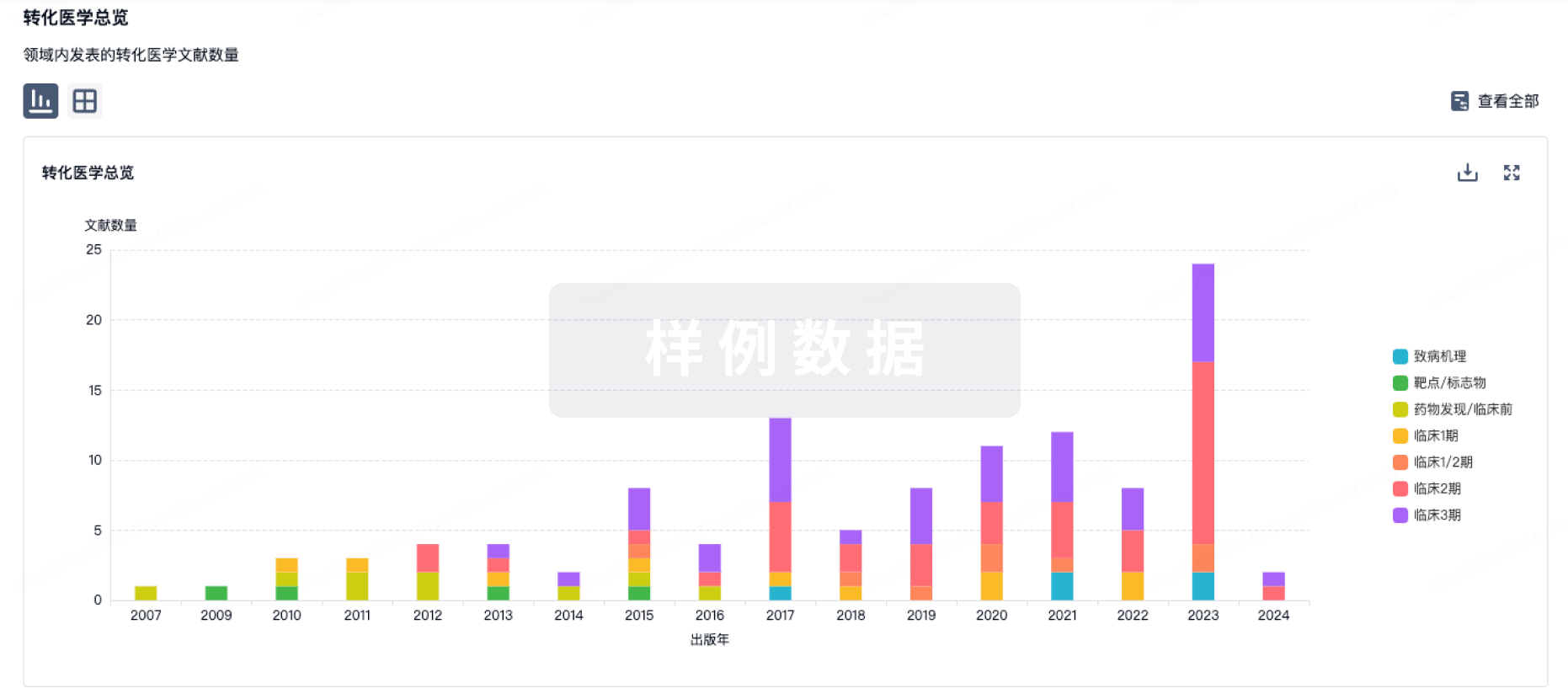
药物交易
使用我们的药物交易数据加速您的研究。
登录
或
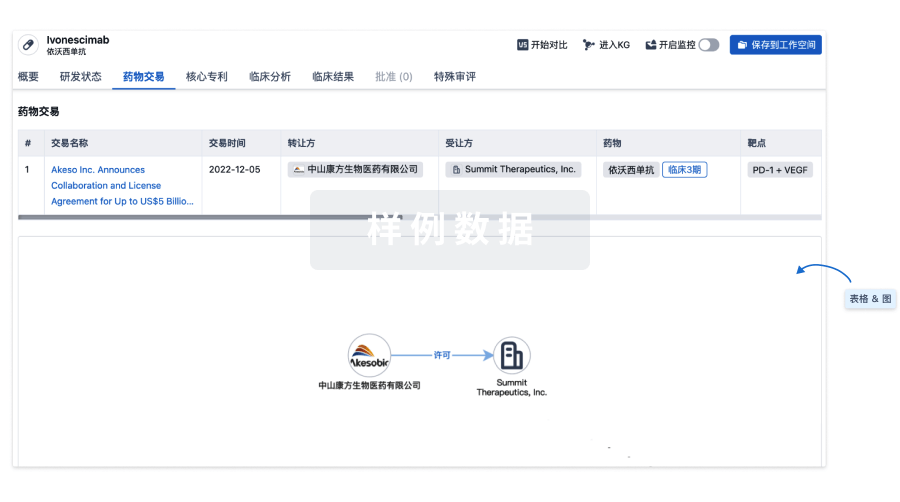
核心专利
使用我们的核心专利数据促进您的研究。
登录
或
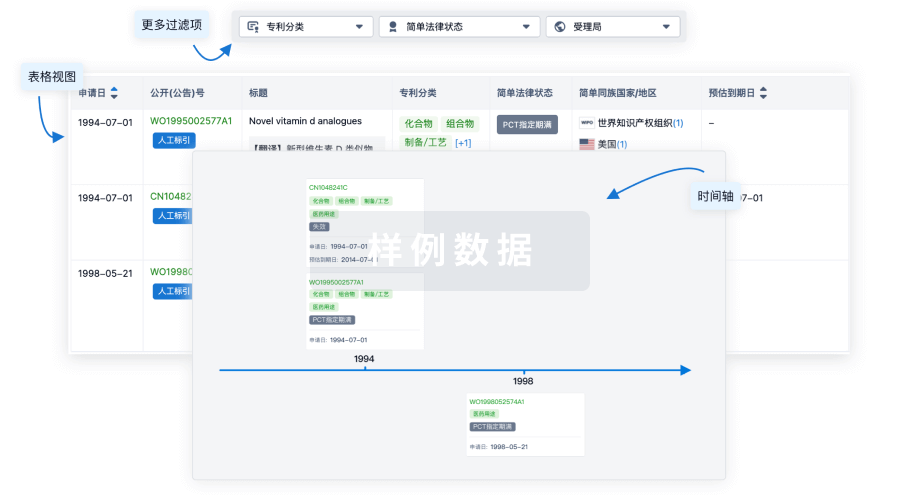
临床分析
紧跟全球注册中心的最新临床试验。
登录
或
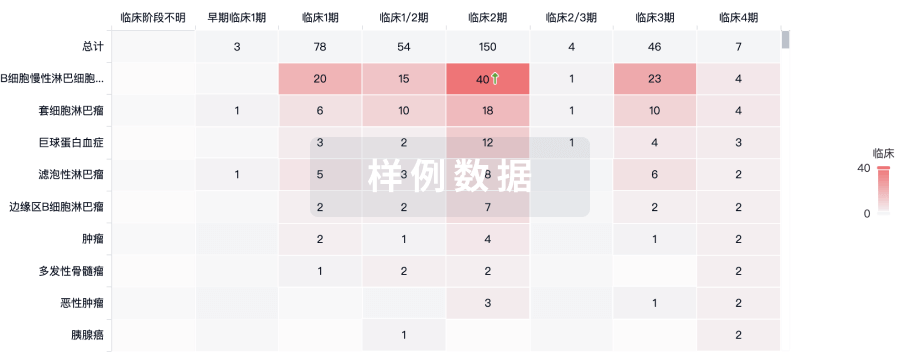
批准
利用最新的监管批准信息加速您的研究。
登录
或
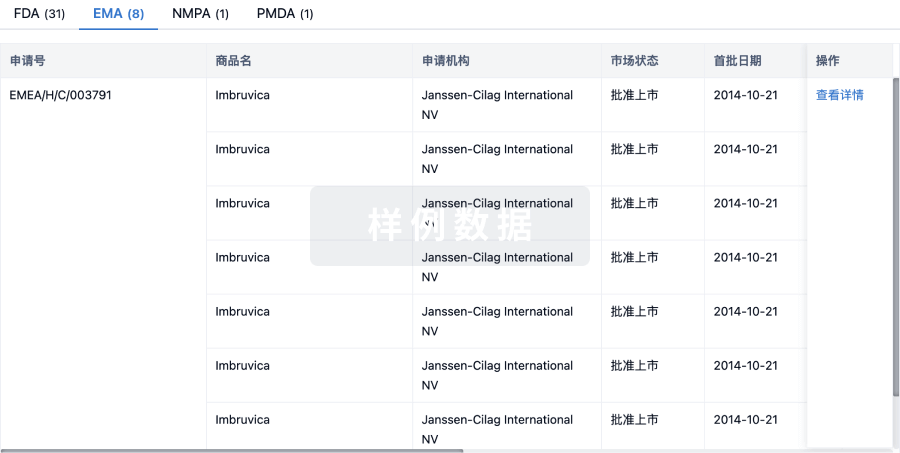
特殊审评
只需点击几下即可了解关键药物信息。
登录
或
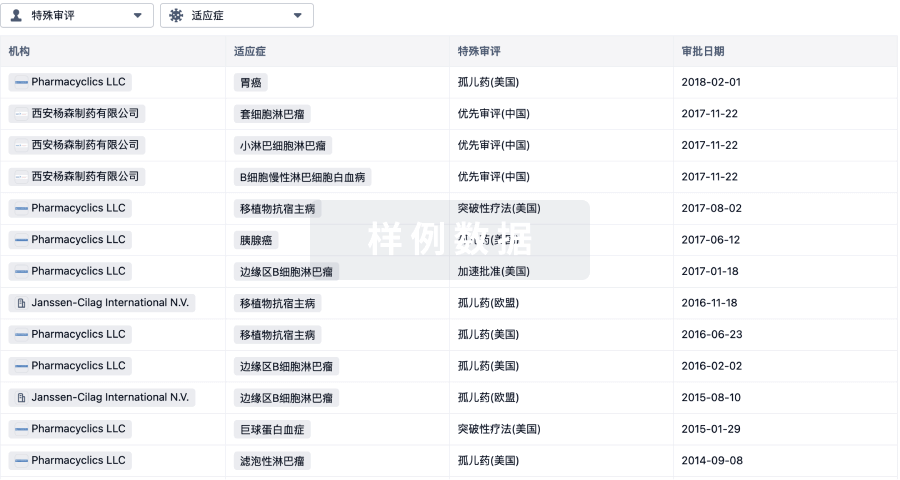
Eureka LS:
全新生物医药AI Agent 覆盖科研全链路,让突破性发现快人一步
立即开始免费试用!
智慧芽新药情报库是智慧芽专为生命科学人士构建的基于AI的创新药情报平台,助您全方位提升您的研发与决策效率。
立即开始数据试用!
智慧芽新药库数据也通过智慧芽数据服务平台,以API或者数据包形式对外开放,助您更加充分利用智慧芽新药情报信息。
生物序列数据库
生物药研发创新
免费使用
化学结构数据库
小分子化药研发创新
免费使用

